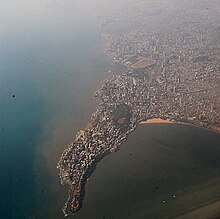South Mumbai
This article needs additional citations for verification. (July 2010) |
South Mumbai
South Bombay Old Mumbai / Mumbai City District | |
|---|---|
Precinct of UTC+5:30 (IST ) |
| Year | Pop. | ±% |
|---|---|---|
| 1971 | 3,070,380 | — |
| 1981 | 3,285,040 | +7.0% |
| 1991 | 3,174,910 | −3.4% |
| 2001 | 3,326,840 | +4.8% |
| 2011 (est) | 3,145,966 | −5.4% |
| Data is based on Government of India Census. Source: MMRDA[1] | ||


South Mumbai,
South Mumbai is also home to many educational institutions; namely
Significance
South Mumbai hosts the
The headquarters of the Brihanmumbai Municipal Corporation, the governing civic body of Greater Mumbai is located in South Mumbai. The Bombay High Court is also in South Mumbai.
The terrorist attacks of 2008 included many prominent South Mumbai locations including
The area houses a significant proportion of prime upmarket residential neighbourhoods of Mumbai including:
South Mumbai is home to two
South Mumbai has many educational institutions such as Jamnalal Bajaj Institute of Management Studies, St. Xavier's College, Government Law College, Jai Hind College, Wilson College, Grant Medical College, Sydenham Institute of Management Studies, Research and Entrepreneurship Education, among others.
Many distinctive sporting clubs have been an integral part of South Mumbai landscape like the
Although land reclamation has allowed the southernmost tip of the district to double in size since the 1970s, the business districts face an acute shortage of real estate. As a result, the real-estate prices are among the top ten worldwide. As a ratio to average per capita income, real-estate prices in the business districts remain the most expensive in the world.[6]
South Mumbai is also home to such sporting grounds as Brabourne Stadium, Wankhede Stadium, Shivaji Park, Azad Maidan, Oval Maidan, and Cooperage Ground.
Mumbai's most popular beach,
South Mumbai has popular art galleries and museums like
South Mumbai has become less congested with the creation of the
Division
The city of Mumbai lies on Salsette Island. Administratively it has two official divisions: Mumbai City district and Mumbai Suburban district. Mumbai City district consists of the Southern part of Salsette Island - the area is called South Mumbai. Mumbai Suburban district consists the Western, Eastern, Central and Northern parts of the city. The northernmost portion of the island - outside Mumbai city limits - lies in Thane district.
Old Bombay

Old Bombay was used to refer to the area which was formed by the merging of the
See also
Notes
- "Population and Employment profile of Mumbai Metropolitan Region" (PDF). Mumbai Metropolitan Region Development Authority (MMRDA). Archived from the original (PDF) on 13 June 2010. Retrieved 4 June 2010.
References
- ^ Population and Employment profile of Mumbai Metropolitan Region, p. 7
- ISBN 978-0-241-43046-0.
- ^ "Malavika's Mumbaistan: Mumbai's North-South Divide". Hindustan Times. 2 July 2021. Retrieved 29 November 2021.
- ^ "Mumbai Terrorist Attacks Of 2008 | Events, Death Toll, & Facts | Britannica". www.britannica.com. Retrieved 16 November 2022.
- ISSN 0362-4331. Retrieved 16 November 2022.
- ^ Sheng, Ellen. "The Five Most Expensive Cities In The World". Forbes. Retrieved 16 November 2022.
- ^ Sobo Films, sobofilms.com. Accessed 1 March 2024.






